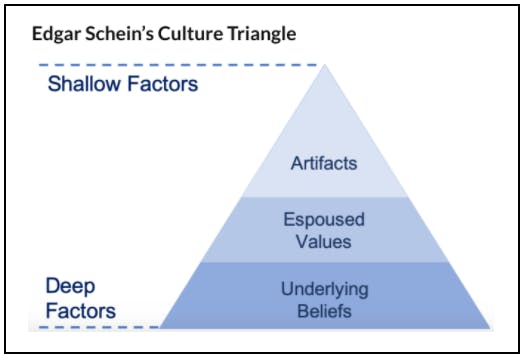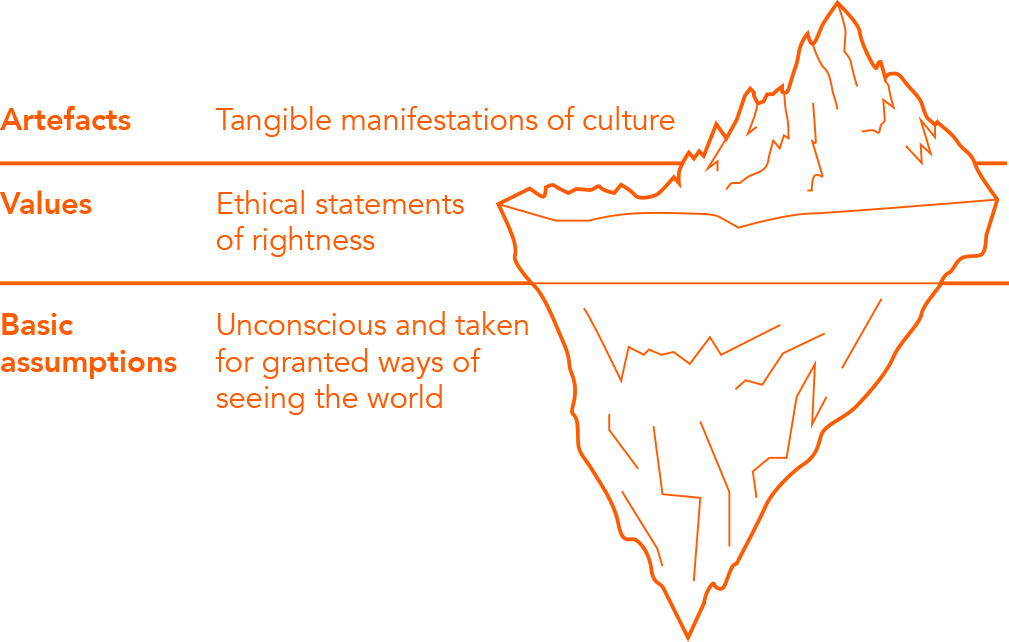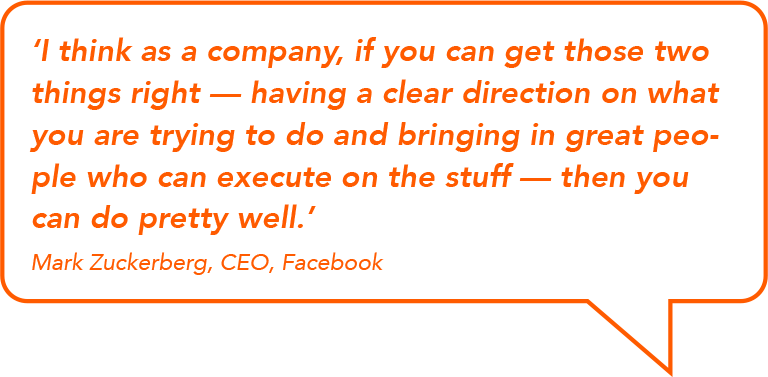Content
Downloads
Growing a Positive Organisational Culture & Vision
Overview
A positive organisational culture emerges through the living out of individual and collective purpose, values and vision. An organisation’s vision provides the blueprint for success and collective purpose provides the necessary guidance. There must be alignment around shared organisational values which become the lived out behaviours of an organisation. Individual and collective investment in purpose and vision must all be supported and achievable.
Organisational culture must be envisioned before being enacted. Negative cultures emerge if no strategy is used to define a vision. In a community committed to learning, a vision and purpose based around positive relational experiences must be the central focus if the right culture is to reveal itself.
Executive Summary
Any learning community wishing to grow a positive organisational culture must initially construct a strong vision statement and use this as its compass and road map for success. The learning community’s organisational structure may also need reimagining to grow a positive culture. It must prioritise relationships to effectively drive its purpose, vision and values.
Edgar Schein, professor at Massachusetts Institute of Technology explains that organisational culture forms from the following factors; artefacts, values and underlying assumptions. Artefacts are the acted out, observed behaviours; visible but hard to decipher. Values are the strategies, goals and philosophies organisations choose to live by. Underlying assumptions are the unconscious, subtle beliefs, habits of perceptions, thoughts and feelings individuals and groups have.

Culture reveals itself in an organisation’s attempt to live out its vision. Those committed to the vision act out the types of values or behavioural characteristics required to succeed. Organisational values, like the vision, must be carefully considered and understood by all its members and lived out in the community. Having the right talent to enact the appropriate values to achieve a vision is critical.
Organisational culture ensures all its members can fasten their own unique vision for success to its overarching vision. This encourages the appropriate values to be lived out in the whole community. Adopting this mindset supports the needs of each individual, enabling them to thrive.
Learning communities operating under a hierarchical model, must reimagine its structure to suit 21st century learning. In a new learning paradigm, a learning community must support the unique passion and purpose of each member to ensure every vision can support and encourage lifelong learning. Individuals living out their unique vision, display the type of values that grow an exceptional culture.

Starting Questions
- Does your learning community place emphasis on its vision as a road map for success?
- Are all members of your learning community aware of its overarching vision statement?
- Do you feel unique visions can be supported and achieved in your learning community?
- Do you spend time evaluating your learning community’s vision and whether the values that are enacted support that vision?
- Does your learning community revisit its vision statement regularly?
- How much emphasis do you place on deliberately shaping a strong learning culture in your community?
Key Initial Actions
- Reconceptualise roles and responsibilities to foster individual and collective growth. With organisational culture, roles should be created and flexible to support individual interest.
- Place vision at the centre of your learning community. It should be the bedrock, foundational core everyone understands and strives towards.
- Ensure individual and collective vision can both be achieved in the learning community to foster organisational culture.
On-going Actions
- Place emphasis on purpose and values ahead of KPIs.
- Hire great cultural fits to help drive success. Getting this right goes a long way to ensuring a positive organisational culture can emerge and grow.
- Ensure wholeness, balance and wellness. This can be reached by ensuring personal interests are met without the interference of organisational commitments.
Find out more
For a new learning paradigm to emerge, it must have an overarching purpose, supported by a shared vision and values that can be understood and acted out by a learning community. It must firstly reimagine its structure to support the growth of a positive organisational culture and it must prioritise relationships to drive its purpose, vision and values.
School organisations typically adopt a hierarchical, top down organisational model. Cultures emerging from this model often fracture or silo the critical links between leadership, staff and students. A top-down model means organisational staff are often intentionally withdrawn from key decision-making processes with leadership assuming control. This sends out the wrong message, particularly when key decisions affect everyone. Student input in a hierarchical organisational model is also often ignored or undermined.
Hierarchical models can be a faux pas for effective culture-building, particularly in organisations dependent on positive relationships to thrive. In schools, a hierarchy can often mean culture is precarious at best. This is reflected by the large number of teachers worldwide quitting the profession early on in their careers because the current organisational model cannot provide success for all.
Key Ideas
- Competition in education creates a toxic culture which hinders a learning community’s ability to thrive.
- Organisational culture emerges from its shared vision and values which can be deliberately shaped through action.
- Organisational culture and structures should be reimagined in learning communities, moving away from the traditional, hierarchical model, to one that serves and supports everyone.
- A TEAL model is an example of an organisational model that can encourage a positive culture and vision to emerge.
Questions
- How much influence do you think measuring success through competition has on shaping organisational culture?
- How can an organisational vision influence culture?
- What actions should a learning community take to ensure its vision supports the type of culture it wishes to grow?
- Why do some organisations fail to produce the type of culture that encourages individual and collective growth, success and thriving?
- How might a learning community reimagine the roles and responsibilities of its actors to encourage a strong culture to emerge?
1. Competition in education creates a toxic culture which hinders a learning community’s ability to thrive.
Schools in traditional learning models are under continued pressure to live up to success based on performance measured by graded assessments. Purpose, vision and values in these meritocracies shrinks among the prevalence of competition which surfaces and influences culture. The perceived power gained by assessment success is often used to exemplify the effectiveness of learning in regions and nations, ultimately driving schools to work harder to ‘win’ by competing against one another. Competition however, hinders real, authentic learning and causes systemic global educational inequality.
Organisational leaders are under continued pressure to produce results for investors and stakeholders who might demand growth or success KPIs to validate their commitments. The same reality exists in education; assessment places high pressure on educators and pupils to demonstrate success and maintain status quo. As a result, organisational culture suffers.
Education should cultivate and celebrate the development and uniqueness of each individual, not measure and compare one person off another. A comparison culture builds mistrust, allows ego to prevail and derails the true purpose, vision and values of those learning communities who wish to make every individual the centre of their learning culture.
The difficulties stemming from competition is through no fault of educational organisations, but existing pressure from society and the traditions that bind it. Growth in our global society is fast becoming a dirty word. Problems like climate change, environmental harms and bio-degradation - we hope the current generation of global learners can solve - are too often ignored to focus on performance and growth. Organisational culture in a new learning paradigm must work towards making education sustainable and equitable for all. This begins with the vision and values that a learning community decides to live by.
2. The culture of any organisation emerges from its shared vision and values which can be deliberately shaped through action.
Culture is the lived, observable reality manifested by any group. It is built from lived values, rites, rituals, norms and stories, collectively manifested to produce the emerging culture. Vision and values that are carefully thought out, decided and shared, are crucial to fostering a strong culture. For an ideal culture to emerge, a school’s organisational structure might need reimagined.
Edgar Schein, professor at Massachusetts Institute of Technology believes organisational culture forms from the following key factors; artefacts, values and underlying assumptions:
- Artefacts are the acted out, observed behaviours - visible but hard to decipher. They are often recognised as the ‘tip of the iceberg’, beneath which are the complex, unseen concepts that influence those observable artefacts; the values and underlying assumptions.
- Values are the strategies, goals and philosophies organisations choose to live by.
- Underlying assumptions are the unconscious, subtle beliefs, habits of perceptions, thoughts and feelings individuals and groups have. Values and underlying assumptions play a huge part in influencing observable artefacts.

Placing education’s purpose, vision and values at the core of all decisions and actions can go a long way to ensuring that an organisation serves everyone.


3. Organisational structures should be reimagined in learning communities, moving away from the traditional, hierarchical model, to one that serves and supports everyone.
Today’s world is witnessing a shift from top-down, hierarchical organisational models, to more horizontal, flat models, where all key actors are valued. The impact of such organisations are seen in the private business sector. This shift is building better cultures as the model evolves from led to shared behaviours.
Organisations can be described as complicated. A common analogy might be a car engine with its cogs and pistons working hard to keep going. The issue with the engine analogy is that if one component breaks, often the whole engine breaks down.
The emerging analogy suited to today’s reimagined organisation is the complex, or natural ecosystem. It adapts, ebbs, flows to solve any problems or events that arise. Another example might be the tree as a complex organism in an ecosystem, with its roots, trunk and branches working harmoniously to ensure it survives and thrives. Not only does the tree work to adapt to change, it is known to work symbiotically to support other trees in its vicinity.

The natural phenomenon of bird murmurations is another way to visualise the behaviours in a complex organisation: Amazing starlings murmuration
You can visualise each bird sensing and responding to movement and change, similar to an organisation that embodies the complex organisational model.
Learning communities would thrive much better in a model that enabled it to sense and respond to changes occurring inside and outside of its sphere of influence, unhindered by the pressure of individual and collective competition.
4. A TEAL model is an example of an organisational model that can encourage a positive culture and vision to emerge.
An agile world requires organisations to adapt to change as it occurs to encourage continual thriving. One of the more successful and widely praised organisational structures emerging is the TEAL model. A TEAL model is the epitome of agile. Change flows naturally in a TEAL organisation by shifting focus from a hierarchical predict and control behavioural structure and pattern, to one of sense and respond.
A TEAL model places high emphasis on self-management, wholeness and evolutionary purpose. It supports individuals in becoming the best version of themselves and empowers them with opportunities to have a positive impact on an organisation’s overall success. One of the crucial factors in the success of a TEAL model is that the overall vision of an organisation can support the vision of every individual, and learning communities must deliver on this if their culture is to remain positive and strong.
TEAL organisations have several key characteristics in common, which are described below:
- Evolutionary purpose
An evolutionary purpose means everyone understands the purpose of their organisation, their position in it, and that they are included in the key processes which foster change. When individuals can attach their own purpose to the purpose of an organisation, it increases motivation and dissolves competition which exists in hierarchical models.

- Values are identified and practiced
Sharing and revisiting values is a high priority in TEAL organisations. Values are those behaviours an organisation recognises as crucial to reaching its overall vision or purpose, so time spent ensuring they are embedded pays dividends in the long run. Ensuring values are discussed and shared means people understand the importance of acting them out and become accountable for them. - Self-management and fixed and shared roles and responsibilities
TEAL organisations create flexible roles and responsibilities. Individuals may complete common tasks but remain flexible to take on new responsibilities. This type of agency encourages proactive behaviour and develops self-management so individuals can manage change and adapt accordingly. Frequently, small teams form to ensure needs are met and nothing goes unnoticed or unchecked. - Wholeness, passion and purpose
The TEAL model recognises that the success of its organisation is constructed by the success of others. In a world where career professionals are predicted to have five or six roles in a lifetime, they must develop the skills to meet immediate and future needs. TEAL organisations nurture every individual, offering continued lifelong learning opportunities. Enabling people to thrive, strengthens and improves positive relationships and collaboration. It also encourages individuals to seek out their own unique pathways, enabling them to remain inspired.
- Shared leadership
In a TEAL model, small teams with shared responsibilities are formed and make key decisions based on shared mission, vision and values. This encourages trust to emerge through emphasis on shared decision-making, shared information flows, collective intelligence and personal growth opportunities. A shared leadership model offers opportunities to grow and develop at a pace that suits each individual while cultivating professional development pathways to support future career pathways.

Reimagining organisational structures might seem radical or a mammoth task, but clinging onto tradition can compromise innovation and progress. Uncertainty must be met with radical ideas, seen at the birth of the Renaissance, the age of enlightenment, the industrial revolution. Change is natural and evolutionary, and the change required to bring forth a new paradigm shift in education must be supported by an evolutionary organisational model to support it. A reimagined organisational model will enable a strong, authentic culture to emerge, which by its nature will support those fortunate enough to experience the force of its impact. Our recent experiences of the global Covid-19 pandemic means reimagining is even more important than ever.
Act now
Luck is not the main factor bringing a positive culture to fruition, but a series of carefully thought out strategies aligning to build a cohesive network of individuals with shared purpose, vision and values. The section below might be best understood as a checklist of actions that leadership ought to consider to grow a positive organisational culture and vision.
1. Reconceptualise roles and responsibilities
Leadership must celebrate the role of each individual if an organisation is to become cohesive. This ensures whole-team equality with individuals empowered no matter their position. Together they form part of the organisational complex.
In some cases, leadership must reimagine its own position. Leadership positions should be used to foster the growth and development of others through power- sharing. Roles should be created that enable micro-teams to form. Micro teams build better cohesion and can foster relationships and empathy.
2. Monitor and evaluate purpose and values
The problem with relating organisational success to KPIs, is that outside observers believe the KPIs are reached by keeping a close eye on numbers. Success is often achieved when the purpose and values of an organisation are lived out, and the outcome of this is the growth or in some cases, KPIs. Placing the monitoring and observation of purpose and values ahead of KPIs will preserve and grow the right type of culture.
3. Place vision at the core of your organisation and let it evolve
The vision of an organisation must be clear, with every single action reflecting it. It should be the bedrock, foundational core everyone understands and strives towards. Vision should be easily attached to the intrinsic and extrinsic motivations of everyone. If you ask the question, ‘why am I doing this?’ the answer should take you straight back to the organisational vision. It is the compass and guiding light for success.
Vision should not be fixed, but monitored with a willingness to evolve it if and when necessary. Altering organisational vision should be a shared envisioning process.
4. Hire great cultural fits
The hiring process is one of the most important aspects driving the success of any organisation. Getting this right goes a long way to ensuring a cohesive team where a positive culture can emerge and grow. Hiring talent does not require the most gifted people, but more importantly those who demonstrate the key values that can be attached to the vision and overarching values of the organisation.
The right attitude goes a long way to creating the right team. The recruitment process should accurately assess the suitability of every individual. Onboarding tasks should be devised to reflect and answer the questions surrounding the organisational vision and values to ensure there is alignment.

5. Ensure wholeness, balance and wellness
Wellness only exists when individuals can balance their lives to ensure personal growth and development. Balance can be reached by ensuring personal interests are met without the interference of organisational commitments. Any organisation should enable the wholeness of each individual to emerge. Essentially there should not be one person holding two entities; the work individual and home individual. The whole self should be welcome in the organisation to foster individual wholeness, balance and wellness.
Finally, the questions below can assist with the envisioning process for developing a positive organisational culture:
- What do we wish we knew?
- What type of people do we wish to have in our organisation?
- What are the daily challenges and struggles we are faced with?
- As we build our organisation, what do we worry about?
- Are workload demands impacting on individual wellness?
- Are the values we advocate being acted out accordingly?
- Is our purpose achievable?
- Do the actions of our organisation align with our purpose?
Examples in action
Some organisations and schools below have restructured and adopted a TEAL or horizontal model for leadership. The examples highlight that any organisation can change its actions to create a positive culture no matter what its vision might be. Some organisations, for example, rely on economic growth to succeed, but this does not mean that they have neglected their vision and values to achieve it.
The Junto Institute The vision at The Junto Institute is to be a global ecosystem of growth, humanity, and virtue with a tribe one million strong. The Junto Institute aims to help leaders and their companies become infinitely better, smarter, and healthier. The values that they advocate, consult and help others develop, are the lived values of their own consultancy - a team of over 100 strong.
Buurtzorg Nederland Buurtzorg is a pioneering healthcare organisation established 12 years ago with a nurse-led model of holistic care that has revolutionised community care in the Netherlands. Client satisfaction rates are the highest of any healthcare organisation. Staff commitment and contentment is reflected in Buurtzorg’s title of Best Employer (4 out of the last 5 years). And impressive financial savings have been made. Ernst & Young documented savings of around 40 percent to the Dutch health care system.
Evangelische Schule, Berlin Zentrum The Evangelical School Berlin Center (ESBZ) is a community school with a vision to empower students to become responsible, sustainable and responsible citizens of the world, to help shape a future worth living for. Social recognition, personal appreciation, dedication and trust based on scientific knowledge and neurobiological fuel for motivation, for learning, the involvement of children and young people and in particular their identity. These basic needs of young people for recognition, appreciation, affection and trust can only be built up through successful interpersonal relationships.
Patagonia Outdoor clothing company who values its employees by hiring individuals who can live and breathe their mission - people who love to spend their time in the great outdoors. Patagonia employees treat work as play and regard themselves as ultimate customers for the products they produce, so purpose and mission aligns to create an organisational culture with similar values.
Resources for Human Development: Bill of Rights and Responsibilities For Employees and Consumers The RHD Bill of Rights and Responsibilities is a collection of writings developed over the past two decades that, together, serve as the framework for the culture they strive to create and maintain within RHD. RHD strongly encourages each employee to carefully read and think about the articles that comprise the document, and to participate actively in making the RHD environment in which he or she works reflect the Bill’s spirit and intent.
Further reading
Download the file here.Special thanks to the following co-creators:
Stephen Harris
Co-Founder & Chief Learning Officer
Bryan Gibson
Research and Paradigm Design
